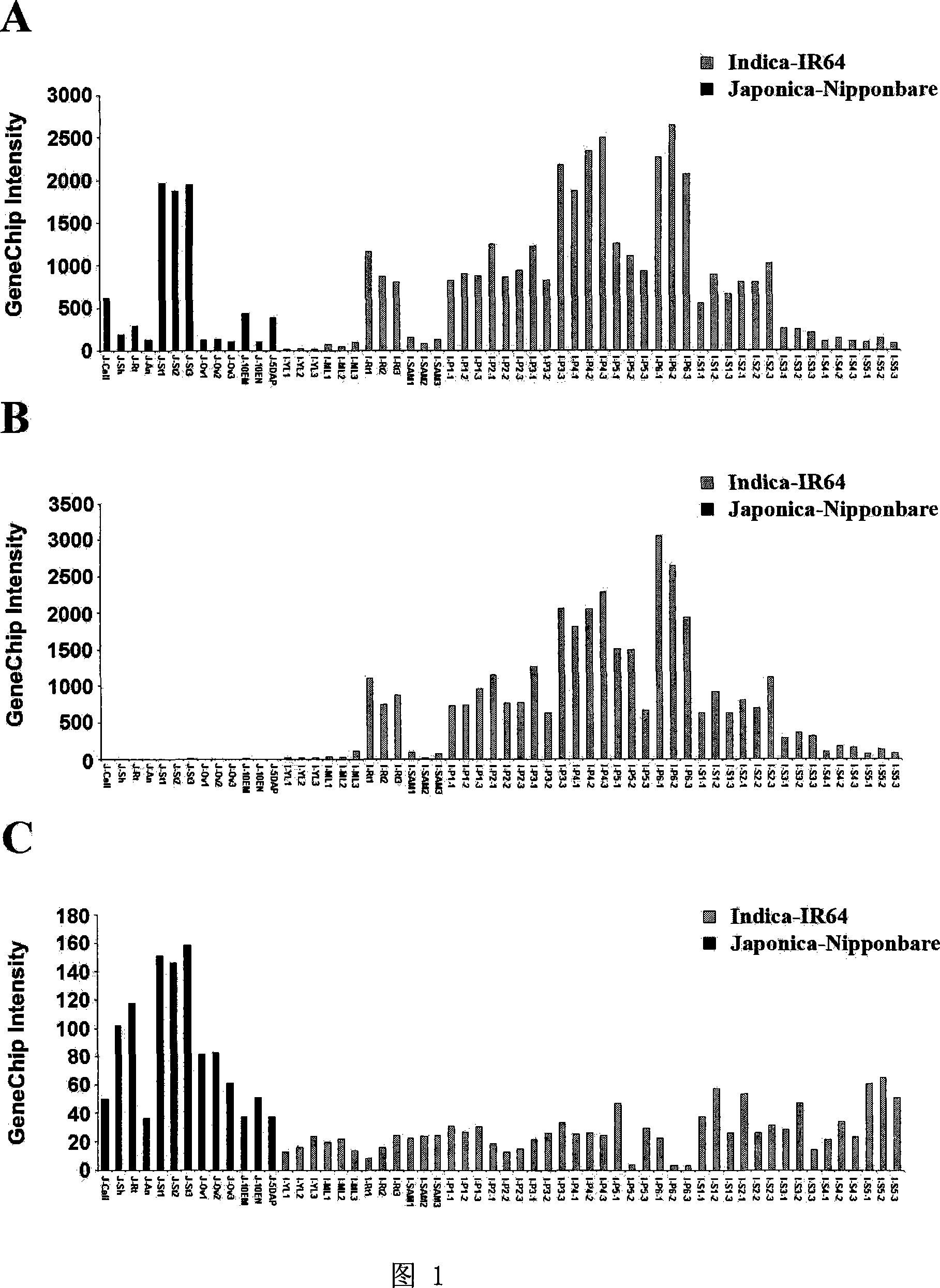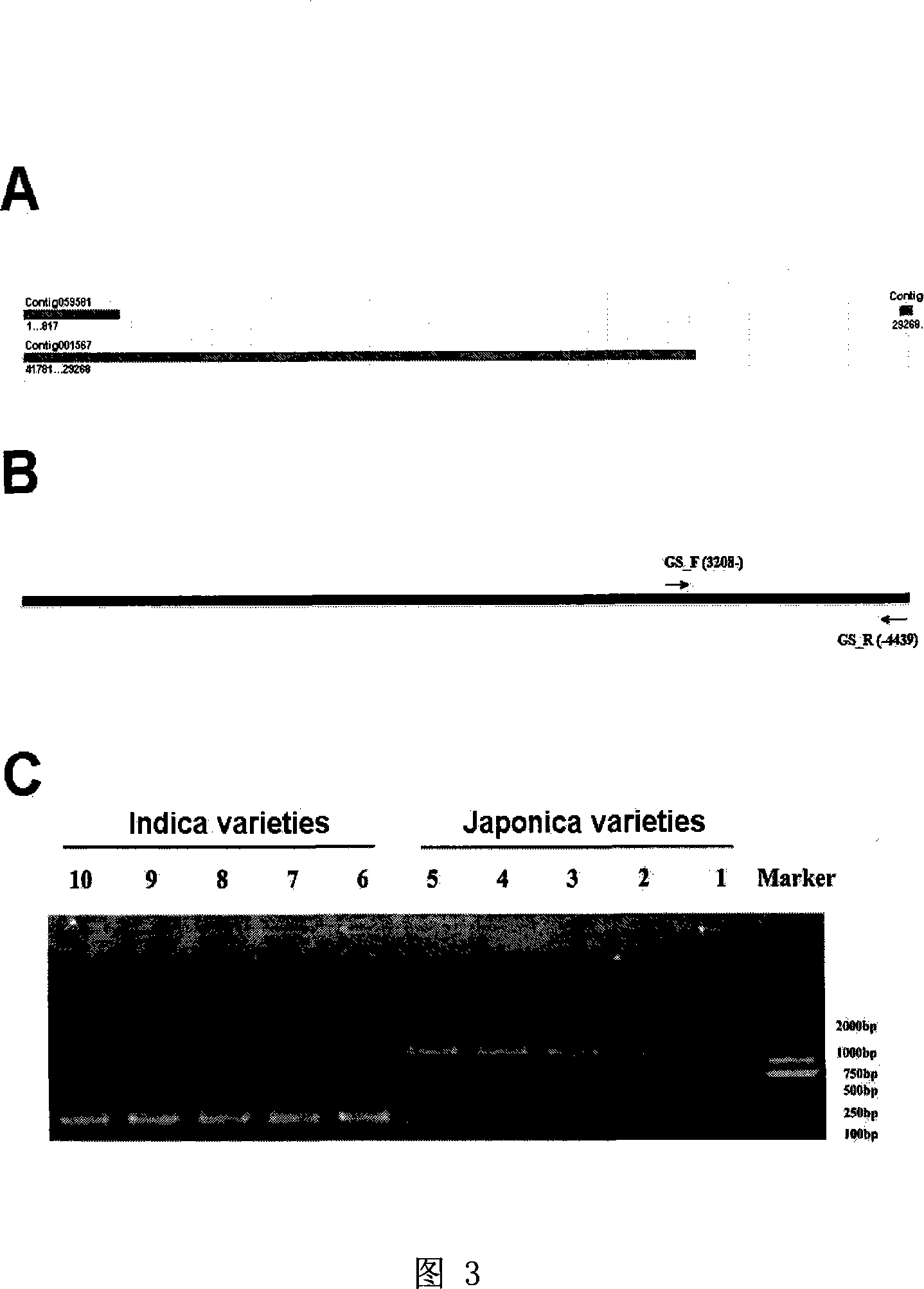Method for assisting sifting motion of nonglutinous rice and non glutinous rice
A technology for indica and japonica rice, which is applied in biochemical equipment and methods, microbial determination/inspection, DNA/RNA fragments, etc., can solve problems such as difficult to study the degree of indica-japonica differentiation in rice, indica-japonica differentiation is not obvious, intermediate, slow, etc. , to achieve the effect of speeding up breeding, low cost and simple operation
- Summary
- Abstract
- Description
- Claims
- Application Information
AI Technical Summary
Problems solved by technology
Method used
Image
Examples
Embodiment 1
[0031] Example 1. Discovery and verification of different expression patterns of gene LOC_Os06g48030 in indica and japonica subspecies
[0032]Through the mining and analysis of indica and japonica rice chip data at different developmental stages and different tissue parts, it was found that the gene LOC_Os06g48030 corresponds to three sets of probes in the GengChip data: Os.11547.1.S1_s_at(PS1), OsAffx.28164.1.S1_at(PS2) and OsAffx.28164.2.S1_at(PS3), in which the probe group PS1 has a higher expression level in indica and japonica rice, and there is no significant difference, while the expression pattern of the probe group PS2 and PS3 in indica and japonica rice is opposite, PS2 only It has a high expression level in indica rice and almost no expression in japonica rice, while PS3 has a very high expression level only in japonica rice tissue, while the expression level in indica rice is very low or even not expressed (Fig. 1, where A is The expression profile of Os.11547.1.S...
Embodiment 2
[0037] Example 2. Exploration of the mechanism of different expression patterns of gene LOC_Os06g48030 in indica and japonica subspecies and the design of primers for auxiliary screening of indica and japonica rice
[0038] In order to explore the mechanism of gene LOC_Os06g48030 different expression patterns in indica and japonica rice, the structure of this gene was analyzed. In view of the fact that this gene lacks the full-length cDNA sequence in indica rice, firstly, Primer3 software was used to design primers FS (the primer sequence of FS is FS_F: 5'-ATGGGGCAGAGGAGGAGGTC-3'; FS_R: 5'-CAAAAAGGAATGGCATATGTATGGGA-3'), and the indica rice 93 -11 and the cDNA of the japonica rice Nipponbare were used as templates for PCR amplification. As a result, only a band of about 1300 bp was detected in the indica rice 93-11 (Fig. 2D). Subsequently, the product was cloned and sequenced, and the sequence is shown in sequence 3 in the sequence table, and the measured sequence and the full...
Embodiment 3
[0043] Example 3. Feasibility verification of primer GS-assisted screening of rice indica and japonica subspecies
[0044] The rice varieties used for verification were all from the National Germplasm Bank: 93-11, IR24, 03A-11, 03A-9, Zhongyou 13, Nipponbare, Hua 1, 746, Yunfeng 7 and Xiangjingnuo.
[0045] Firstly, 8 varieties and landraces (4 indica and 4 japonica) were randomly selected using morphological indicators and related literature search, as shown in Table 2:
[0046] Table 2. Identification results of indica and japonica subspecies of 8 rice varieties and landraces
[0047] rice variety
PUM
 Login to View More
Login to View More Abstract
Description
Claims
Application Information
 Login to View More
Login to View More - R&D
- Intellectual Property
- Life Sciences
- Materials
- Tech Scout
- Unparalleled Data Quality
- Higher Quality Content
- 60% Fewer Hallucinations
Browse by: Latest US Patents, China's latest patents, Technical Efficacy Thesaurus, Application Domain, Technology Topic, Popular Technical Reports.
© 2025 PatSnap. All rights reserved.Legal|Privacy policy|Modern Slavery Act Transparency Statement|Sitemap|About US| Contact US: help@patsnap.com



